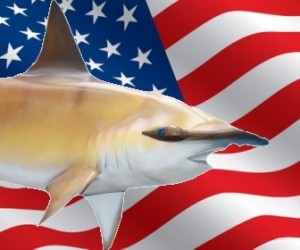United States to support Shark Proposals at CITES CoP16
 News Release
News Release
U.S. Fish & Wildlife Service ( USFWS )
January 23, 2013
—————————-
U.S. to Support Trade Restrictions on Five Shark Species and All Manta Rays at International Wildlife Trade Meeting
Information on Marine Species Proposals: Oceanic Whitetip Shark, Scalloped Hammerhead, Great Hammerhead, Smooth Hammerhead, Porbeagle Shark and Manta Rays
CITES is an international agreement initiated in 1973 and since then ratified by 177 nations (referred to as “Parties”) to protect certain wild animals and plants from over-exploitation as a result of international trade. Approximately 34,000 species benefit from CITES protection. Species protected by CITES are included in one of three appendices, which convey varying levels of protection to species listed under each appendix.
Each signatory nation determines how to implement these protections, typically by regulating import and export and investigating and prosecuting illegal trafficking of listed species and products containing those species. As a Party to CITES, the United States may propose amendments to the appendices for consideration at the meeting of the Conference of the Parties (CoP), including proposals for species to be included in, removed from, or transferred between the CITES appendices (i.e., species proposals).
Every two to three years, a meeting of the CoP – the world’s largest and most influential meeting on international wildlife trade – is held to review, discuss and negotiate changes in the implementation of CITES, including changes in protections for certain species. The 16th such meeting since the agreement’s inception (CoP16) will take place in Bangkok from March 3-14, 2013.
The United States, Colombia and Brazil have submitted a proposal for consideration at CoP16 to include the oceanic whitetip shark (Carcharhinus longimanus) in Appendix II. The primary threat to the species is an unsustainable harvest to supply the shark fin trade. Shark fins are particularly in demand as a food item. A recent stock assessment indicates that certain populations of this species have declined markedly. The species shows low population growth rates and a moderate recovery potential and productivity compared to other shark species. Oceanic whitetip sharks are currently listed on the International Union for the Conservation of Nature (IUCN) Red List of Threatened Species as Critically Endangered in the northwest and central Atlantic Ocean, and Vulnerable globally.
The United States will support a proposal that Brazil, Colombia, Costa Rica, Ecuador, Honduras, Mexico and the European Union have submitted to list three species of hammerhead shark in Appendix II, including the scalloped hammerhead (Sphyrna lewini), great hammerhead (Sphyrna mokarran), and smooth hammerhead (Sphyrna zygaena). The primary threats to these shark species are targeted and bycatch fisheries. Hammerhead sharks are harvested primarily for the international fin trade, and current catch levels are considered unsustainable. The IUCN Red List includes the scalloped hammerhead and the great hammerhead as Endangered globally and the smooth hammerhead as Vulnerable globally. The scalloped hammerhead, great hammerhead, and smooth hammerhead all occur in the coastal waters of the United States.
The United States will support a proposal co-sponsored by Brazil, Comoros, Croatia, the European Union and Egypt to list porbeagle sharks in CITES Appendix II. Porbeagle sharks are commercially valuable for both their fins and its meat and are taken in both targeted and bycatch fisheries. The international demand for porbeagle meat and fins has driven populations to very low levels across its range. Recent assessments show that because porbeagle populations have been severely depleted, it is unable to fulfill its key role in the marine ecosystem.
The United States will support a proposal co-sponsored by Brazil, Colombia, and Ecuador to include manta rays in CITES Appendix II. Manta rays are assessed on the International Union for the Conservation of Nature (IUCN) Red List of Threatened Species as Vulnerable globally. They bear only one pup on average every two to three years, which makes them highly vulnerable to overexploitation. In recent years, manta ray fishing has expanded in many places throughout their range, primarily in response to the emerging international market for their gill plates. Manta ray gill plates are the most valued part of the manta ray in international trade.
Source: USFWS
